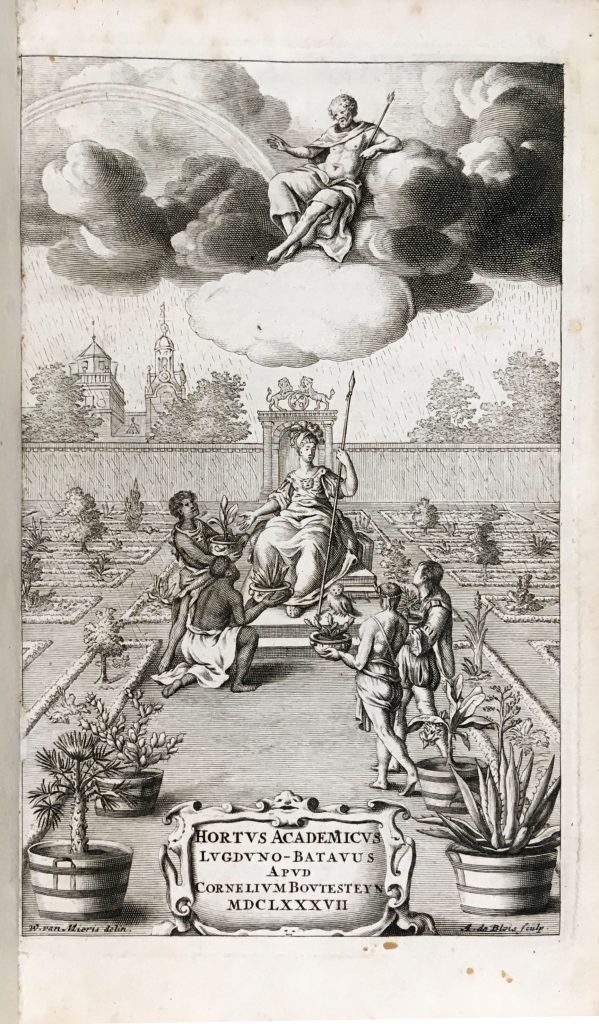“Pollinators” Exhibit Extended through August 13; More about Bees
The lovely exhibit Pollinators curated by Carly Sentieri has been extended through August 13 – we encourage you to come see the riches she has identified in our holdings in Special Collections.
On a recent trip to the Netherlands I had the privilege of visiting, if too briefly, the botanical gardens of the University of Leiden. The Hortus botanicus Leiden, the oldest botanical garden in the Netherlands, is closely associated with the botanist Charles L’Ecluse (his name was latinized as Carolus Clusius), who held the chair in botany at the University of Leiden from 1593 until his death in 1609.

The garden features, among other attractions, a replica of a small apiary with straw beehives: the original apiary stood in the garden ca. 1595, under the care of the first garden manager, Dirck Outgaertszoon Cluyt (his name was latinized as Theodorus Clutius).
Clutius was the first Dutch author to write a book on honeybees, Van de byen … (Leiden, 1597), in the form of a dialogue between himself and Clusius, who directed the garden. (Clutius & Clusius!)
The Miller Bee Collection in Special Collections has two 17th-century editions of Clutius’ work:

- Vande bien: Haren wonderlijcken oorspronck natuer, eygenschap, crachtighe ongehoorde ende selsaeme wercken; waer in gemerckt worden hare wonderlijcke politien ende eerlijcke regeringen, die sy met haren coninck, ende onder malcanderen onderhouden. Vervatet in dry Boecken, Seer ghenuchelijck om te lesen … in’t corte begrepen staet (t’Antwerpen: by Joseph Jacops …, [1655-1689?]), call number: RTYMB C629 1620 Bee Collection, with the bookplate of H. J. O. Walker. https://search.library.wisc.edu/catalog/9910038097302121
- Van de byen, haer wonderlicke oorsprong, natuer, eygenschap, krachtighe, ongehoorde en seltsame wercken … (t’ Amsteldam: by Johannes van Ravesteyn, 1653), call number: RTYMB C629 1653 Bee Collection. https://search.library.wisc.edu/catalog/9910038098502121
We also hold numerous works written or compiled by Clusius, including his Rariorum aliquot stirpium per Hispanias observatarum historia (Antwerp: Ex officina Christophori Plantini, 1576), said to be his first entirely original publication;

Rariorum aliquot stirpium, per Pannoniam, Austriam, & vicinas quasdam prouincias obseruatarum historia (also published by Plantin, 1583); and Exoticorvm libri decem: Quibus animalium, plantarum, aromatum, aliorumq́ue peregrinorum fructuum historiae describuntur (likewise published by Plantin, 1605).
Our collection also includes various catalogs of the Hortus botanicus Leiden, among them Paul Hermann, Horti academici Lugduno-Batavi catalogus (Leiden: Apud Cornelium Boutesteyn, 1687 — see the engraved allegorical title page above) and an expanded version of Herman Boerhaave, Historia plantarum, Quæ in Horto academico Lugduni-Batavorum crescunt cum earum charecteribus [sic], bearing the spurious London imprint “Sumptibus Societatis” [that is, the Royal Society of London], 1738. The Historical Collections at Ebling Health Sciences Library include a Rome edition of Boerhaave’s work from 1727, by the way.
— R. Rider

